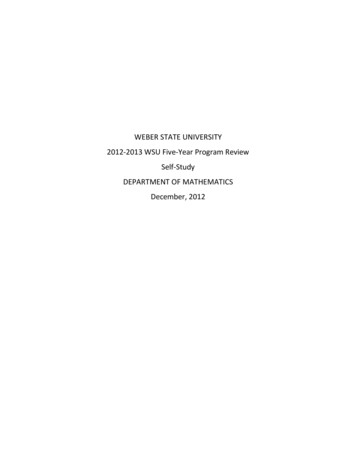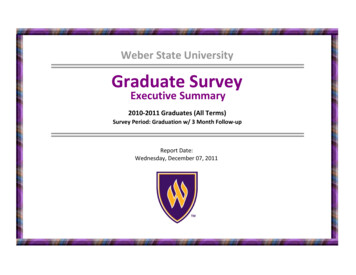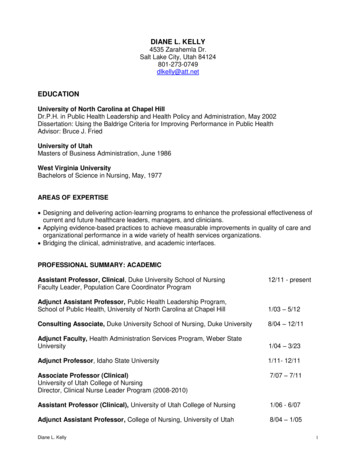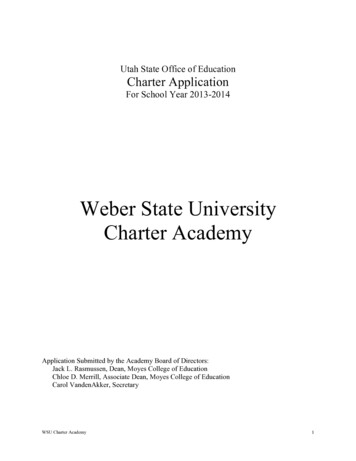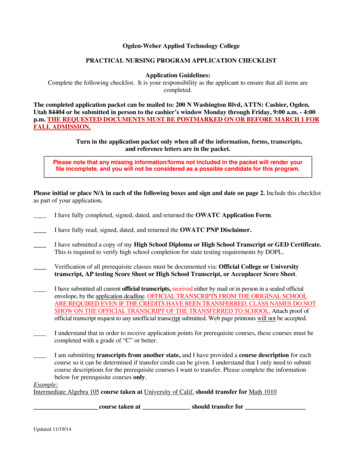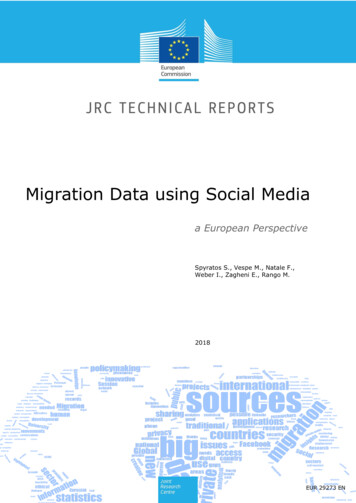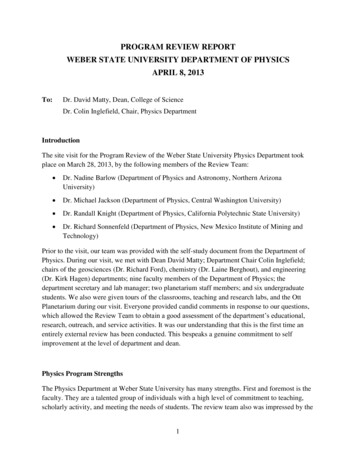
Transcription
PROGRAM REVIEW REPORTWEBER STATE UNIVERSITY DEPARTMENT OF PHYSICSAPRIL 8, 2013To:Dr. David Matty, Dean, College of ScienceDr. Colin Inglefield, Chair, Physics DepartmentIntroductionThe site visit for the Program Review of the Weber State University Physics Department tookplace on March 28, 2013, by the following members of the Review Team: Dr. Nadine Barlow (Department of Physics and Astronomy, Northern ArizonaUniversity) Dr. Michael Jackson (Department of Physics, Central Washington University) Dr. Randall Knight (Department of Physics, California Polytechnic State University) Dr. Richard Sonnenfeld (Department of Physics, New Mexico Institute of Mining andTechnology)Prior to the visit, our team was provided with the self-study document from the Department ofPhysics. During our visit, we met with Dean David Matty; Department Chair Colin Inglefield;chairs of the geosciences (Dr. Richard Ford), chemistry (Dr. Laine Berghout), and engineering(Dr. Kirk Hagen) departments; nine faculty members of the Department of Physics; thedepartment secretary and lab manager; two planetarium staff members; and six undergraduatestudents. We also were given tours of the classrooms, teaching and research labs, and the OttPlanetarium during our visit. Everyone provided candid comments in response to our questions,which allowed the Review Team to obtain a good assessment of the department’s educational,research, outreach, and service activities. It was our understanding that this is the first time anentirely external review has been conducted. This bespeaks a genuine commitment to selfimprovement at the level of department and dean.Physics Program StrengthsThe Physics Department at Weber State University has many strengths. First and foremost is thefaculty. They are a talented group of individuals with a high level of commitment to teaching,scholarly activity, and meeting the needs of students. The review team also was impressed by the1
level of collegiality among all members of the Physics Department. The faculty and staff clearlywork as a team to achieve the department’s mission and goals, and they have a great amount ofrespect for each other’s responsibilities and accomplishments. The ability for the department tocreate and sustain a productive and collaborative working environment should be promoted as auniversity model. The sustained level of faculty accomplishments is also noteworthy.The department has had a solid and consistent degree production of about 11 students per yearover the past five years. This is more than twice the national average for undergraduate physicsdegrees, and the department is to be commended for this. The students we spoke with hadnothing but praise for the department, especially the small classes and getting to know facultymembers well. Some of the students said that they had not begun as physics majors but hadswitched to physics because of exciting introductory courses – a credit to faculty teaching theseclasses.Students also were outspoken about how much they liked being able to conduct research withfaculty members, and many are involved in investigations conducted with the High AltitudeReconnaissance Balloon for Outreach and Research (HARBOR) project. Support forundergraduate research comes from both internal and external funding sources. The studentshave a resource room set aside for them within the department (an important attribute ofsuccessful departments that should be continued in the new building) and have recentlyrevitalized the Physics Club. The students are pleased with the level of advising they receive andthe accessibility of all the faculty members.The chairs of the geosciences, chemistry, and engineering departments confirmed that studentsare the physics faculty’s first priority and that students (both majors and those in the service andgeneral education classes) receive a solid foundation in physics. Faculty are well-respected byother departments on campus and by all students who take their classes.Despite their high teaching loads, faculty are engaged in a wide variety of scholarly andprofessional activities. These range from participating in national and internationalcollaborations to textbook writing to serving as editors of highly respected journals.Faculty also are very involved in university administration and governance, which is recognizedby the administration through release time for several faculty members. We found evidence of afairly strong commitment to shared governance by the university’s top administration, which iscritically important in difficult financial times.The department has a very strong outreach program, both through individual faculty efforts andby the staff and students at the Ott Planetarium, which reaches out to K-12 students and thepublic within the local region.The faculty expressed great optimism for the future, both in terms of possible growth of theprogram and for improvements in space with the new science building. We believe this optimism2
is warranted and that the department’s strengths provide a solid foundation from which to growand improve.Physics Program WeaknessesThe Physics Department has a number of readily identified weaknesses. Some of these can bedealt with by the department, but others will need a commitment from the college and theuniversity. Our goal in making these observations is to start a conversation about how thephysics department can move from being a good, collaborative, and functional physicsdepartment to a thriving physics program. Along those lines, we ask the department andmembers of the administration to read the SPIN-UP report prepared by the National Task Forceon Undergraduate Physics if they are unfamiliar with this y: The Review Team’s greatest concern is with the demographics of the departmentfaculty. The most recent tenure-track hire was about ten years ago, half of the faculty have beenteaching for 20 years or more, and several are very near retirement. Currently there are noassistant professors in the department. Three of 13 regular faculty members are women (23%),although one of those is a visiting professor; there is little ethnic diversity. Six faculty membershave reassignments ranging from 0.16 to 0.5 FTE and others are working on a reduced-timebasis. As a result, the effective faculty size is closer to 10 FTE than to 13 (12 tenured and 1visiting professor).The faculty felt they are just barely able to cover the necessary teaching assignments with their12 credit unit loads per semester, and were concerned that this would be a problem if anyoneretired, if additional reassignments occurred, or if anyone took a sabbatical (we were surprisedand concerned to learn that few faculty members ever take a sabbatical because “Who wouldteach my classes?”). While the basic curriculum is adequate, there are not enough faculty to offerelectives that would better prepare students for graduate school or careers. Even worse, someadvanced laboratories seem to hinge on just one faculty member, a situation that is notsustainable.Most of the evening classes and labs are currently taught by adjunct faculty. However, both thefaculty and the chair noted the difficulty they have in finding qualified adjuncts within the localarea.Faculty expertise is primarily concentrated in two areas: theoretical physics and astrophysics. Adepartment this size cannot have both breadth and depth, so a concentration in a couple of areasis reasonable. However, both students and faculty commented on the need for more faculty withexpertise in experimental physics. Currently only a small subset of the faculty – largely those3
with experimental expertise – oversee the vast majority of student research projects. Somestudents commented it was difficult to find an advisor for research projects.While the faculty’s efforts to keep everything going are commendable, they are overstretchedand this level of effort is unsustainable.Research: Weber State, like most universities in its class, is pushing faculty to engage in moreresearch and scholarly activity. We believe that undergraduate involvement in research is avaluable educational experience. At the same time, it is essential, at the college level, to clearlydefine what “research” means in the context of WSU’s mission and what, realistically, faculty atWSU can do. Weber State cannot compete with R1 universities that have graduate students,extensive lab space and other infrastructure, and faculty with minimal teaching loads.That said, the Physics Department is woefully short of space for carrying out even small researchprojects. We visited 3 small research rooms, each barely larger than 100 square feet. We arehighly concerned that the new science building is being proposed at more-or-less the samesquare footage as the current building, which, even with careful design, will not allow anadequate expansion of research and student project space. If the faculty evolves over the next 5–10 years to, say, 6 or 7 experimentalists, a minimum of 3000 square feet of research and projectspace will be needed if the university is serious about having faculty do more research.New faculty currently receive little or no start-up funding to get any research underway. At R1schools, start-up packages for experimentalists are often several hundred thousand dollars.Weber State cannot compete with this, as noted, but it does need to offer experimentalists on theorder of 50,000 (or high-end computers for theorists who do lots of computation) just tocompete with other universities in its class. The physics department will be at a seriousdisadvantage for hiring new faculty unless it can offer space and some kind of start-up package.In addition, faculty receive little time or credit for carrying out research or supervising studentprojects. The amount of load credit they receive for this important task is minimal – typically0.25 TCH or less per SCH. The combination of high teaching, service assignments to both theuniversity and their profession, outreach activities, and mentoring of undergraduate studentslimits the amount of time that faculty members can devote to original research.We also heard concerns about the university’s Purchasing Department and Office of SponsoredProjects. These had been points of concern in the department’s previous review. It appears thatthese offices were not designed for and are unfamiliar with the requirements of scientificresearch. We heard some evidence that OSP has new personnel and is improving, but this is partof the university infrastructure that the university as a whole needs to focus on if it is seriousabout having more research activity on campus.Teaching: The physics faculty is committed to quality teaching, but nearly all teach using verytraditional lecture-based classes. We saw little evidence of innovative pedagogy. The majority of4
faculty felt they were unable to institute innovative teaching methods due to the currentclassroom size, setup, and enrollment. Few seemed aware of research or of practices elsewherethat demonstrate the extent to which educational outcomes can be improved even in a largelecture hall setting. Some faculty expressed optimism that the new science building wouldalleviate some of these difficulties so they could utilize techniques such as studio physicsinstruction. However, the review team did not find that many of the faculty members wereparticularly interested in moving away from a lecture-only format. This may be due, in part, tothe high loads that leave little time for reflection on course redesign.Students: A major issue raised by several faculty members was the inadequate preparation ofstudents entering Weber State University for the sciences. Many students have to take severalsemesters of remedial mathematics before they can take calculus and thus enter the physicsprogram. While on paper there are currently 142 physics majors, the majority seem to be lostbefore ever reaching their first physics classSome of those less-well prepared students could possibly be retained if the department found away to engage the students during this period of additional preparation. Some strategies thedepartment may consider include Offering a physics- or physics/engineering-oriented class for students who needadditional math preparation. One example is Nathan Klingbeil’s model at Wright StateUniversity: “Introductory Mathematics for Engineering Applications.” Offering more pre-calculus physics courses. Astronomy is already offered, butconceivably course on meteorology (possibly jointly taught with geosciences) or energycould be added, as could a course such as “Physics for Future Presidents,” which hasbeen wildly popular at U.C. Berkeley (and there’s a book with this title by Berkeley’s Dr.Richard Muller, who developed the course).As best we could tell, the College does not actively recruit high school students into the STEMdisciplines and does not work directly with Admissions in this area. The department web page,which could serve as a useful recruitment tool, is lacking much of the necessary information toattract qualified incoming students to the program.The number of women physics majors is low but not out of line with national norms. However,ethnic diversity is very low. The large and rapidly increasing Hispanic population of Utah is notbeing well served. Both active recruiting and a better web page could help with this.Students interested in conducting research in areas not covered by the faculty’s areas of expertisedo not seem to be aware of summer research programs such as the NSF’s Research Experiencesfor Undergraduates or NASA’s Undergraduate Student Research Internships where they couldobtain this type of experience. However we are uncertain if this is due to a lack of promoting thisopportunity or to a student reluctance to leave the immediate area.5
Assessment: Based on the information in the self-study, the department does not seem to have awell-defined assessment plan or to be making much effort at assessment. In part this may stemfrom confusion between course-level assessment and program-level assessment. It is the missingprogram-level assessment that could help the department better plan how to make improvementsin the face of limited resources.Budget and Support: Two other areas of concern are the budget and the inadequate technicalsupport. The budget seems only marginally adequate for current activities. There is little moneyfor travel (and the faculty do not travel to meetings or workshops nearly as much as they shouldto stay current) and no money to expand or improve what the department currently does. Thetechnician and one faculty member provide all of the technical support for both classrooms andthe machine and wood shops. There is no technical support for upper-division labs, which putsan even larger burden on the faculty who teach those labs. If department staff are ill, offices canclose and services become unavailable, which can further exacerbate the problem. Studentassistants to help in the office and with the set up/take down of instructional laboratories wouldseem a low-cost solution to improving support. However, we should note that both the technicianand the secretary were adamant that they did not want a student assistant.Physics Program OpportunitiesThe Department of Physics has a number of opportunities on which it could capitalize. Mostimportant is the potential near-term retirements within the tenured faculty, which will provide anopportunity to significantly alter the expertise and demographics of the department. To takeadvantage of this, the department needs to think roughly ten years ahead in terms of programgoals and most particularly new faculty hires. These discussions should include consideration ofhiring experimental physicists in disciplines to be determined by the faculty, which could expandthe breadth of the department’s expertise and enhance undergraduate research opportunities forthe students while maintaining the level of teaching excellence the department has come toexpect. The department should also discuss the possibility of shared positions with otherdepartments. In our discussion with the chairs from other departments, geosciences expressedinterest in perhaps a joint appointment for a geophysicist.We believe that there is good cause to expand the full-time faculty to 14 or 15 over the next 5–10years, and to authorize a search for next year in anticipation of retirements. This could help tokick-start a departmental rejuvenation, but the current faculty need to make the case for this. Thedepartment also should consider increasing the number of full-time instructors (lecturers orvisiting professors) on one- or two-year contracts for use in place of part-time adjunct faculty.6
A second department opportunity is to provide input on the design of the new science building inorder to obtain larger research laboratory space, better support facilities (i.e., shops), betterteaching laboratories, and teaching spaces that allow use of a variety of demonstratedpedagogical techniques, such as “studio physics”. There was a suggestion of creating an“imaging suite” that would include AFM, SEM, and phase contrast microscopes. Any suchproposals need to get into the queue early and be argued for forcefully.The department also should consider conducting strategic planning in the area of recruitingcalculus-ready students to their program. A good place to start would be with an upgrade to thedepartment web site, which can be used to “sell the story” of the benefits of pursuing a physicsdegree at Weber State (i.e., smaller class sizes than at the R1 universities, personalized facultyattention, undergraduate research opportunities, etc.). The website should include betterdescriptions of the tracks with sample degree plans; better descriptions of careers in physics,with case studies of department alumni (career information is the number-one thing high schoolseniors want to know about); and the current “links to nowhere” need to be fixed. This may be achallenge because the department currently does not have direct editorial control of its website,so we urge the dean to instruct the consultant to work with the department on this issue. Whilethe college is able to use the College of Applied Science and Technology’s STEM recruiter,more can be done. The department could become more proactive in building a partnership withAdmissions and using their recruiters (especially the STEM recruiter) to sell their program tohigh school students. Another possibility is for the department to consider using fee waivers tohelp attract calculus-ready students.During our discussions we heard of several industries in the area with which closer ties could beestablished (i.e., Hill AFB, L-3 Communications, Northrop Grumman, and Autoliv). While thedepartment should be commended on its current connection with industry, these relationshipscan be significantly strengthened. One way of achieving this is forming an advisory board withrepresentatives from these companies. The advisory board could help the department betterprepare their students for careers with local industry along with providing fundraising assistancefor scholarships and research internships.Physics Program ThreatsThe biggest threat currently facing the Department of Physics is the need for new tenure-trackfaculty lines. The loss of even one faculty member would immediately and substantially reducethe number of courses the department could offer, including in general education areas. Thegrowth of the new Engineering Department also will put pressure on the department’s offering ofservice courses and require additional staffing. The difficulty of recruiting experimentalphysicists to the program due to lack of space and start-up funding jeopardizes the types ofcourses that can be offered by the department and the options for undergraduate research.7
Another threat is that the new science building, as currently proposed, does not provide asubstantial gain of floor space over what the department currently has available. Thereforeteaching, research, and office space will continue to limit the opportunities for the departmentand will not allow the department to grow if the university grows. This seems to us extremelyshort-sighted and contrary to the long-term interests of the university.Faculty in the Department of Physics take on an excessive amount of service to the college anduniversity. The hiring of adjuncts to cover the teaching obligations of reassigned faculty is notoptimal and enhances the threat to the department if any faculty member leaves. The faculty areovercommitted with heavy teaching and service loads, outreach, and mentoring of undergraduatestudents on research projects. This type of scenario often leads to burnout of the most productivefaculty members and is a very real threat facing this department. While department memberswere generally stoic, we heard some faculty members saying, “You have to help us this is notsustainable”.RecommendationsThe Review Team offers the following recommendations:1.Insist that the plans for the new science building be revised to ensure that the departmentwill have adequate space to meet its current and anticipated future needs. Being locked in toinadequate space will be the death knell of any hoped-for improvements. Consider whether someof the old science building can be saved.2.Develop a 5–10 year strategic hiring plan to expand the depth, breadth, diversity, andexpertise of the faculty in the Department of Physics and to ensure that supervision of studentresearch is spread equitably among the faculty. This in turn will benefit the students byexpanding the diversity of courses offered and the types of research opportunities available.3.Initiate a search next year, then replace retiring faculty immediately.4.Develop an agreed-upon definition of the term “research” that the department and collegecan use for planning purposes and in tenure and promotion decisions. Focus on existingdepartment strengths, which are mentoring students in undergraduate research and research inthe area of science teaching and learning. Although PUIs are generally not competitive with R1institutions regarding the generation of external research funding, the University’s supportoffices, such as Purchasing and the Office of Sponsored Research, need to become moreproficient at supporting the research needs of the science faculty.8
5.Develop and implement a long-term assessment plan for program-level assessment toascertain how well the department is meeting its overarching goals and objectives. Documenthow the results of assessment are used to improve the program.6.Increase the number of faculty attending meetings and workshops to remain current intheir field and to learn about new pedagogy.7.Expand the department’s recruiting effort to improve diversity and the number ofcalculus-ready students who come to the program.8.Increase recognition of faculty who supervise undergraduates within a research setting.Possible solutions to consider include reducing teaching loads for faculty active in research orincreasing the amount of credit hours faculty receive for supervised student research.9.Encourage students to apply for summer research programs such as NSF’s ResearchExperiences for Undergraduates or NASA’s Undergraduate Student Research Internships.10.Form an advisory committee composed of representatives from local industries who haveinterests in a physics-educated workforce. Use this advisory committee to help designcoursework useful to students who plan to pursue industry careers, provide career advice,identify off-campus internship opportunities, etc.SummaryThe Department of Physics at Weber State University is good but has the potential to be better. Itis a collegial and student-focused department composed of dedicated faculty and staff. However,chronically excessive academic loads caused by a shortage of staffing threaten the corecompetency and mission of the department in the near term. The department needs additionaltenure-track faculty lines in order to accommodate the increasing demands on its service classesand undergraduate research opportunities for its majors. The department excels in the quality ofits courses, its service to the College and University, and its commitment to outreach to thecommunity. However, the department needs substantial additional space in order to provideclassrooms that support more effective pedagogical methods and research opportunities for bothfaculty and students. The proposed size of the new science building is of such serious concernthat we recommend finding a way to enlarge it or protect some fraction of the existing sciencebuilding. Recruitment of calculus-ready students to the program could be enhanced by improvingthe department website and working more closely with a university STEM recruiter. Closer tiesto local industries would benefit both the faculty and students.9
ADDENDUM: ANSWERS TO DEAN MATTY’S QUESTIONSPHYSICS DEPARTMENT REVIEW COMMITTEE 3/28/2013Nadine Barlow, Michael Jackson, Randall Knight, Richard SonnenfeldIs the curriculum appropriate compared to national trends or models?This is a standard physics program that teaches appropriate material in preparation for a varietyof careers. As with past department practices, continued reflection on the curriculum isencouraged, particularly if new faculty with varying expertise are hired.Is a common core present for major/minor tracks? Is a common core preferred?The common core for the major/minor tracks is appropriate.Is the curriculum flexible to allow students different options?There is some flexibility due to multiple degree tracks but there is a lack of faculty breadth(particularly in applied areas) that limits some important electives (e.g., atomic and molecularphysics, optics, laser physics).Is the curriculum agile and able to change rapidly as workforce needs change?Because it is a strong physics core, it provides a wide range of basic preparation for mostimaginable workforce needs. It is not agile in the sense of courses or course content changingrapidly because that is not an issue in the undergraduate physics curriculum – unlike, say, incomputer science where languages evolve quickly.Are pedagogical methods being used appropriate for today's learners?Physics-education-research-based pedagogical techniques are used sporadically andinconsistently. Conversations with the department indicate most introductory courses are taughtusing a very traditional lecture-based pedagogy with separate, somewhat independent, labactivities. There appear to be limited inquiry or exploratory activities being used. Even if largelecture sections are required, some techniques such as peer instruction and interactive lecturedemonstrations could be used. The use of the planetarium to enhance understanding in theintroductory astronomy classes is commendable, but it does not substitute for in-class inquirybased activities. Due to the limited duration of our review, some of these techniques may be usedmore in the department than the self-study and our interviews led us to believe. The department10
appeared open minded about such techniques and some faculty are currently using project-basedlearning activities.With that said, the department should have a serious conversation about revising its instructionalactivities starting with the introductory courses. Timing is particularly acute given this will be alarge influence affecting the design of the new science facility, decisions that will affect the next50 years. For example, while moving their instruction to an integrated lecture/lab course wouldresult in a slightly higher TCH for the same number of students, it would employ pedagogicaltechniques demonstrated through physics education research to show improved studentunderstanding of the material.Is the department student-focused throughout?Yes!!! A very significant strength and the students absolutely agree.Is the assessment plan for all programs adequate?Assessment activities appear scattered. We recommend less, but more targeted, assessment. Itmay not be clear to the faculty what the goal of assessment is. We wonder if the institution as awhole has agreed on the purpose of assessment. Is it individual courses or entire programs? Werecommend assessment activities focused on the entire program. The senior seminar coursecould be expanded to address the programmatic outcomes of the department. The use of rubricswould also be beneficial when assessing across the department.Should the department be investigating associate’s degrees and certificates which could beintegrated into the major?Introducing an associate degree into the curriculum would add only marginal value. Certificatesfor targeted training for local employers could be a revenue generator for the department – IF thedepartment is allowed to retain the income. However, there appear to be only a couple of facultywith the expertise to offer such a program, assuming the certificate would largely be in appliedphysics. An added challenge is that the applied/experimental physics faculty is a group havingthe least breadth within the department and who appear to us to be the most overloaded, largelydue to the number of undergraduates they need to mentor.What opportunities exist for partnering/working with other departments to develop newprogram or strengthen existing programs?11
The geoscience department expressed interest in a shared faculty hire in the area of geophysics.This could be a way of adding breadth to the department and increasing collaboration within theCollege. Future opportunities may exist with the expansion of engineering. We did not have timeto learn about the physics-teaching track, so we do not know what kind of partnerships mayalready exist with the College of Ed
WEBER STATE UNIVERSITY DEPARTMENT OF PHYSICS APRIL 8, 2013 To: Dr. David Matty, Dean, . While on paper there are currently 142 physics majors, the majority seem to be lost . One example is Nathan Klingbeil's model at Wright State University: "Introductory Mathematics for Engineering Applications." .


